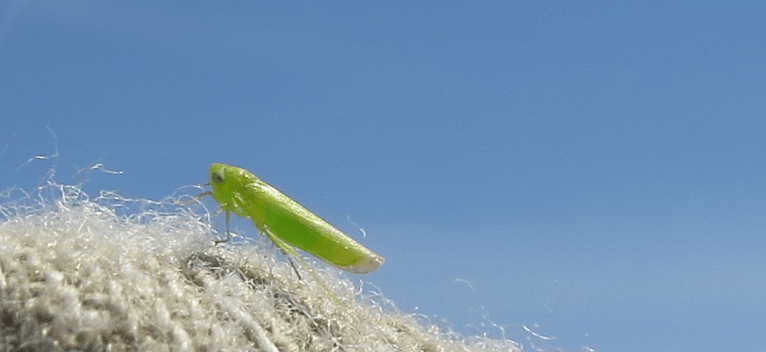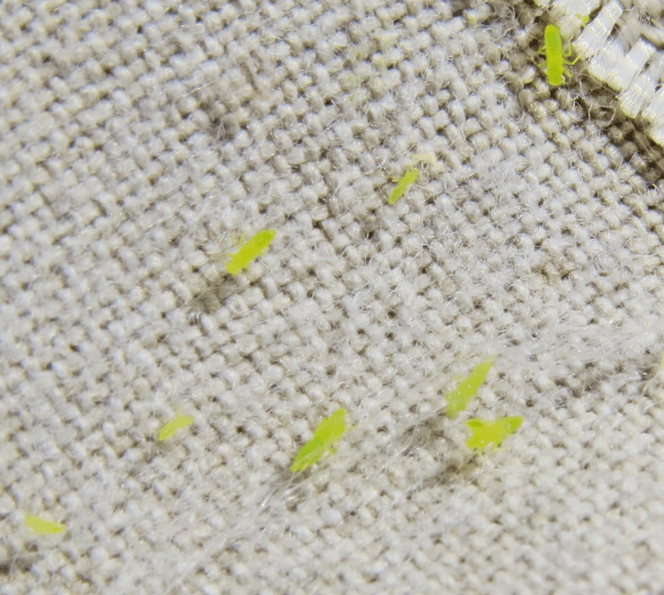Ken Wise and Jaime Cummings NYS IPM
Across the state, there are many reports of potato leafhopper (PLH) approaching threshold in alfalfa. It is important protect your alfalfa quality by knowing what to do and how to determine if a field has a problem.
This insect pest does not over-winter in the Northeast. Adult PLHs migrate on weather from south and south-west part of the county each year. This year we have had a lot of storms and weather fronts. Many field consultants are reporting finding many numerous adult PLHs in alfalfa fields.
This lime green, slender 1/8 inch long insect can move from plant to plant laying 2-3 eggs per day. Bright yellow-green nymphs hatch from the eggs in search of plant juices.


Adults alone seldom reach threshold (and they already have this year), but the combination of the nymphs and the adult can really cause significant damage to the forage. Both the nymphs and adults have piercing-sucking moth parts. As they suck the sugary phloem juices from the plant, they replace it with their toxic saliva.
Large infestations of potato leafhopper in alfalfa can reduce the plant crude protein by 5% and yield by a ½ ton per acre per cutting. If you see V-shaped yellowing on the tips of the leaves you have a good chance that potato leafhopper has been in your alfalfa. This weakens the plant and it will have slower re-growth after harvest and increased chance of winter kill.


It is TIME TO SCOUT YOUR FIELDS! Use a 15-inch diameter sweep net to determine if a field is at threshold.
You will want to scout from now until late August. Use the potato leafhopper sequential sampling plan to determine if an infestation requires management or not. The first thing to do is determine the height of your alfalfa. Smaller plants are more vulnerable to potato leafhopper; thus there are different action thresholds for different heights of alfalfa. The second thing you will need to know is how to sample for potato leafhopper.
A sample consists of a set of 10 sweeps of the net. A sweep is one pass in front of you as you walk through the alfalfa. The return swing is counted as another sweep.
Since sequential sampling reduces the number of samples that taken, it reduces the time in each field and tells you whether to treat (management action) or not treat (no management action). Sequential sampling is particularly helpful in minimizing time required to make a management decision in situations where PLH populations are very high or very low. Use the following chart to determine potato leafhopper infestation levels.
 Write down the number of potato leafhoppers for each sample taken on the card. Add each sample to the next, keeping a running total of potato leafhoppers. You will need to take at least 3 samples using the sequential sampling method. On the sequential sampling card “N” is defined as no treatment (no management) needed at this time and “T” is defined as treatment (management) needed within in a week. If the sample is smaller than the “N” number stop and scout 7 days later. If the number of leafhoppers is larger than the “T” number then management action needs to be taken within a week. If the number of potato leafhoppers fall between “N” and “T” then continue and take the next sample till a decision can be determined. A guide with a printable version of the sequential sampling chart can be found at: http://www.nysipm.cornell.edu/publications/plh.pdf
Write down the number of potato leafhoppers for each sample taken on the card. Add each sample to the next, keeping a running total of potato leafhoppers. You will need to take at least 3 samples using the sequential sampling method. On the sequential sampling card “N” is defined as no treatment (no management) needed at this time and “T” is defined as treatment (management) needed within in a week. If the sample is smaller than the “N” number stop and scout 7 days later. If the number of leafhoppers is larger than the “T” number then management action needs to be taken within a week. If the number of potato leafhoppers fall between “N” and “T” then continue and take the next sample till a decision can be determined. A guide with a printable version of the sequential sampling chart can be found at: http://www.nysipm.cornell.edu/publications/plh.pdf
Now you need to know what to do if an infestation reaches a management action level. The good news is that you have three good options for controlling an infestation of potato leafhoppers in New York alfalfa.
Option 1: Early Harvest
You can harvest the alfalfa early to control PLH if the field is within a week to ten days of a scheduled harvest. By harvesting the alfalfa early, you’ll prevent potato leafhopper from reaching infestation levels that can cause yield and quality loss to the forage. Make sure that the whole field is harvested at the same time. If a field is not clean harvested then the alfalfa that has not been cut will serve as a refuge for PLH that can re-infest; thus severely damaging alfalfa re-growth.
Option 2: Use an Insecticide
To protect yield and health of new seedings and established alfalfa, insecticide control may be warranted when an infested field is not within a week of harvest. For selection of an insecticide, consult the current issue of Cornell Guide for Integrated Field Crop Management. Remember to read the label and be aware of blooms, bees and the days until harvest restrictions.
Option 3: Plant Potato Leafhopper Resistant Alfalfa
A third option for control is planting PLH-resistant alfalfa. Obviously, it is a little late for this season’s crop but something to consider for future seedings. Research has shown that potato leafhopper resistant alfalfa is consistently higher in quality than susceptible alfalfa varieties with or without potato leafhopper pressure. PLH-resistant variety yields are comparable and generally better than susceptible varieties when PLH are present. A bonus benefit is that currently available alfalfa varieties with PLH resistance have come down in price over the past several years.
PLH DAMAGED ALFALFA NOTE: If you have standing alfalfa with potato leafhopper yellowing across the field, it is best to clip off the alfalfa instead of treating it, and then monitor the regrowth. The reason is that the quality of the PLH damaged forage is going to be poor, at best, and you will get a better quality forage if you protect the regrowth.
For more information check our online IPM video: Time to Scout for Potato Leafhopper in Alfalfa

